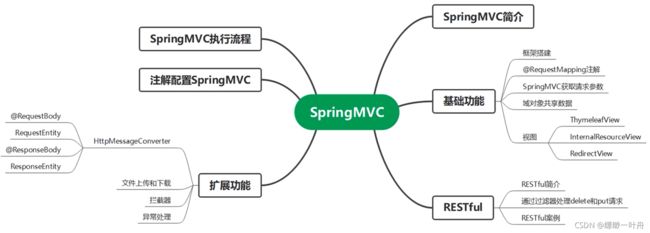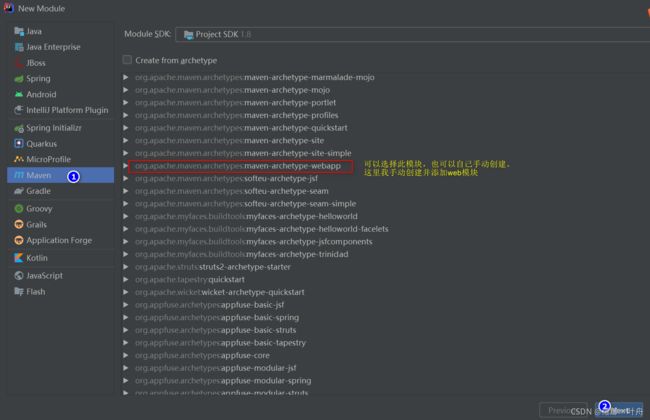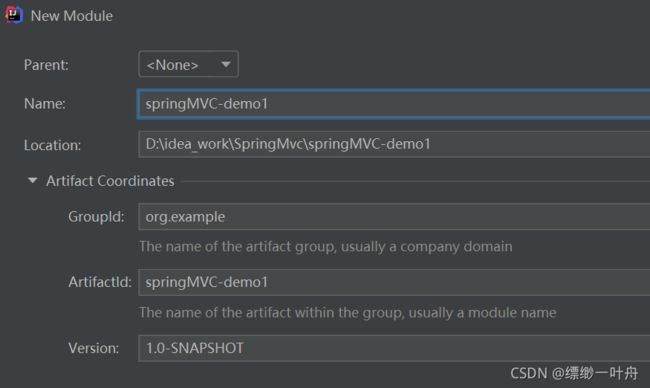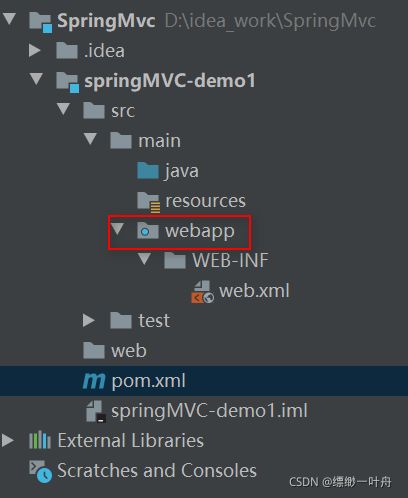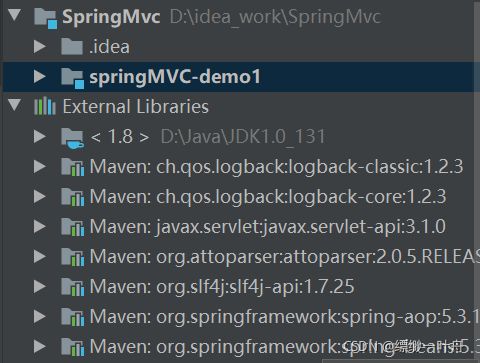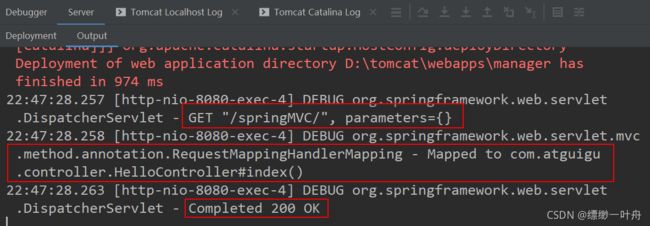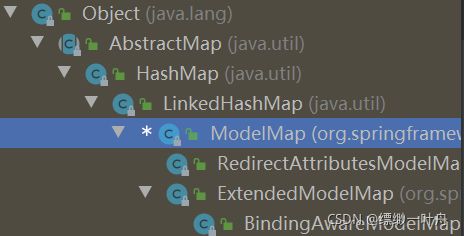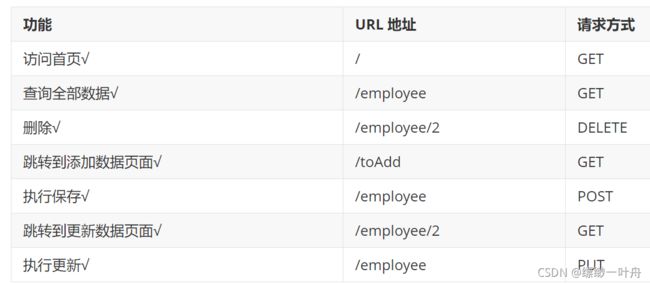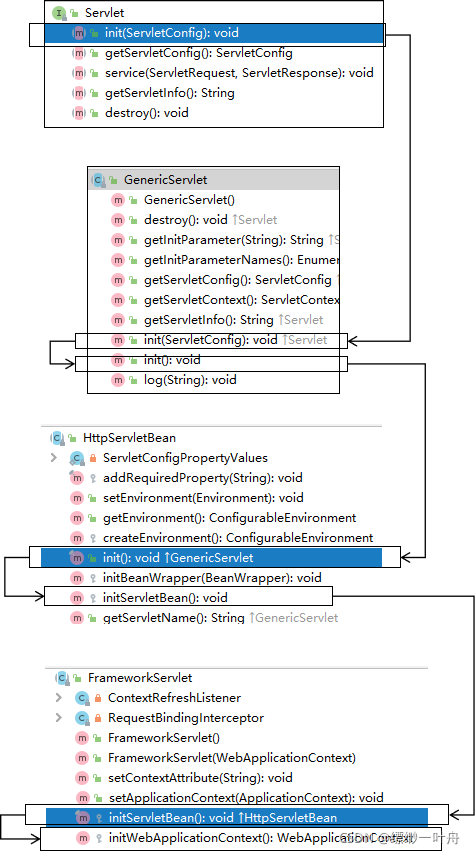SpringMVC学习笔记
学习路线:
JavaSE:学习面向对象的概念及特点,类,接口方法等基础知识以及关系型数据库,JDBC的使用和JDBC的简单封装
JavaWeb:学习浏览器和服务器相关的技术,遵循HTTP协议完成浏览器和服务器之间的交互,在WEB工程中使用三层架构完成功能的实现过程,即表现层,业务层,持久层。
SSM:Javaweb在实现指定功能的过程中这些功能都具有相同的模式和流程,因此需要考虑功能扩展,将固定的模式和流程进行封装,提供代码的重用率,需要用到框架。SSM框架整合是目前最流行的框架结构。SpringMVC是SSM框架的重要组成部分。
本次课程主要内容:
IDE :IDEA
构造工具:Maven
Thymeleaf:视图渲染
核心技术:SpringMVC5.3.1版本
目录
一、SpringMVC简介
1、什么是MVC
2、什么是SpringMVC
3、SpringMVC的特点
二、搭建SpringMVC框架
1、开发环境
2、创建maven工程
3、配置web.xml
4、创建请求控制器
5、创建springMVC的配置文件
6、测试HelloWorld
7、总结
三、@RequestMapping注解
1、@RequestMapping注解的功能
2、@RequestMapping注解的位置
3、@RequestMapping注解的value属性
4、@RequestMapping注解的method属性
5、@RequestMapping注解的params属性(了解)
6、@RequestMapping注解的headers属性(了解)
7、SpringMVC支持ant风格的路径
8、SpringMVC支持路径中的占位符(重点)
四、SpringMVC获取请求参数
1、通过ServletAPI获取
2、通过控制器方法的形参获取请求参数
3、@RequestParam
4、@RequestHeader
5、@CookieValue
6、通过POJO获取请求参数
7、解决获取请求参数的乱码问题
五、域对象共享数据
1、使用ServletAPI向request域对象共享数据
2、使用ModelAndView向request域对象共享数据
3、使用Model向rqequest域对象共享数据
4、使用map向request域对象共享数据
5、使用ModelMap向request域对象共享数据
6、Model、ModelMap、Map的关系
7、向session域共享数据
8、向application域共享数据
六、SpringMVC的视图
1、ThymeleafView
2、转发视图
3、重定向视图
4、视图控制器view-controller
七、RESTful
1、RESTful简介
2、RESTful的实现
3、使用RESTFul模拟操作用户资源
模拟get和post请求
HiddenHttpMethodFilter处理put和delete请求
模拟PUT和DELETE请求
八、RESTful案例
1、准备工作
功能清单
2、具体功能:访问首页
3、具体功能:查询所有员工数据
4、具体功能:删除
5、具体功能:跳转到添加数据页面
具体功能:执行保存
6、具体功能:跳转到更新数据页面
9、具体功能:执行更新
八、HttpMessageConverter
1、@RequestBody
2、RequestEntity
3、@ResponseBody
4、SpringMVC处理json
5、SpringMVC处理ajax
6、@RestController注解
7、ResponseEntity
九、文件上传和下载
1、文件下载
2、文件上传
十、拦截器
1、拦截器的配置
2、拦截器的三个抽象方法
3、多个拦截器的执行顺序
十一、异常处理器
1、基于配置的异常处理
2、基于注解的异常处理
十二、注解配置SpringMVC
1、创建初始化类,代替web.xml
2、创建SpringConfig配置类,代替spring的配置文件
3、创建WebConfig配置类,代替SpringMVC的配置文件
十三、SpringMVC执行流程
1、SpringMVC常用组件
2、DispatcherServlet初始化过程
3、DispatcherServlet调用组件处理请求
4、SpringMVC的执行流程
一、SpringMVC简介
1、什么是MVC
- 一类称为实体类Bean:专门存储业务数据的,如 Student、User 等
- 一类称为业务处理Bean:指Service或Dao对象,专门用于处理业务逻辑和数据访问
2、什么是SpringMVC
注:三层架构分为表述层(或表示层)、业务逻辑层、数据访问层(持久层)。表述层表示前台页面和后台servlet,前台页面发送请求到服务器中,服务器使用servlet接收请求进行处理并响应浏览器。SpringMVC 对上述功能实现封装,我们只需要使用SpringMVC提供的功能代码完成请求的处理。
3、SpringMVC的特点
二、搭建SpringMVC框架
1、开发环境
构建工具:maven3.5.4
服务器:tomcat7
Spring版本:5.3.1
2、创建maven工程
new module--maven--选择archetype,让idea自动创建maven工程。以下演示手动创建步骤
org.springframework
spring-webmvc
5.3.1
ch.qos.logback
logback-classic
1.2.3
javax.servlet
javax.servlet-api
3.1.0
provided
org.thymeleaf
thymeleaf-spring5
3.0.12.RELEASE
注:由于 Maven 的传递性,我们不必将所有需要的包全部配置依赖,而是配置最顶端的依赖,其他靠传递性导入。
maven导包的时候碰到的问题Cannot resolve plugin org.apache.maven.plugins:maven-war-plugin:2.2
webappt添加路径就有蓝色的小点。上述步骤完成后文件夹下有了web.xml,web.xml是web工程入口的配置文件,包含注册servlet,过滤器,监听器等。之后这部分用注解配置类方式代替xml配置文件。
web工程打成war包后,依赖的jar包会被放到webapp目录下的WEB-INFO下的lib中
解决方法:可能是项目的.iml文件当中没有相关依赖的信息,只需要在项目目录下执行以下命令重新生成.iml文件,:
mvn idea:module 并在IDEA右侧的Maven projects中对应的Module名称上右键,选择Reimport即可更新相关依赖。
a>默认配置方式
配置文件位置名称默认
springMVC
org.springframework.web.servlet.DispatcherServlet
springMVC
/
此配置作用下,SpringMVC的配置文件默认位于WEB-INF下,默认名称为
maven工程配置文件统一放到resources下,通过扩展配置实现。(最优)
springMVC
org.springframework.web.servlet.DispatcherServlet
contextConfigLocation
classpath:springMVC.xml
1
springMVC
/
在resource下创建配置文件
resources----右击-----new----xml configure file----spring Config,新建springMVC.xml
4、创建请求控制器
由于前端控制器对浏览器发送的请求进行了统一的处理,但是具体的请求有不同的处理过程,因此需要创建处理具体请求的类,即请求控制器。
请求控制器中每一个处理请求的方法成为控制器方法。当前需要的数据已经在前端控制器中获取,我们只需要创建方法,通过SpringMVC中的方式去匹配到这个方法。
一般处理请求的servlet要实现servlet接口或继承HTTPServlet,SpringMVC中处理请求的控制器就是一个POJO(Plain Ordinary Java Object:普通的Java对象),因为SpringMVC的控制器由一个POJO(普通的Java类)担任,因此需要通过@Controller注解将其标识为一个控制层组件,交给Spring的IoC容器管理,此时SpringMVC才能够识别控制器的存在
package com.atguigu.controller;//包名可以为controller或handler(处理器)
import org.springframework.stereotype.Controller;
@Controller
public class HelloController {
}5、创建springMVC的配置文件
text/html
application/json
6、测试HelloWorld
// localhost:8080/springMVC/
@Controller
public class HelloController {
//"/"-->/WEB-INF/templates/index.html
//请求映射注解,处理请求和控制器方法间的映射关系
//注解的value属性可以通过请求地址匹配请求,/表示的当前工程的上下文路径
@RequestMapping(value = "/") //浏览器发送的请求是上下文路径时,就会执行注解所表示的方法
public String index(){//请求匹配到的方法和方法名无关
/**返回视图名称,视图名称决定了最终要跳转到的页面。我们返回的视图名称
会被配置的视图解析器解析,前缀+视图名称+后缀
*/
return "index";
}
}给项目配置tomcat
运行出现问题
成功运行后
b>通过超链接跳转到指定页面
首页
首页
HelloWorld
在请求控制器中创建处理请求的方法
@RequestMapping("/hello")
public String HelloWorld() {
return "target";
}7、总结
三、@RequestMapping注解
1、@RequestMapping注解的功能
从注解名称上我们可以看到,@RequestMapping注解的作用就是将请求和处理请求的控制器方法关联起来,建立映射关系。
SpringMVC接收到指定的请求,就会来找到在映射关系中对应的控制器方法来处理这个请求。
如果有多个请求控制器,并且处理的请求地址相同时,springMVC会报冲突错误。要保证所有的控制器中requestmapping匹配的地址是唯一的。
2、@RequestMapping注解的位置
@RequestMapping标识一个类:设置映射请求的请求路径的初始信息(先访问到初始信息,再访问到具体信息),经常用于区分不同模块的控制器
@RequestMapping标识一个方法:设置映射请求请求路径的具体信息(和浏览器发送的请求关联)
@Controller
@RequestMapping("/test")
public class RequestMappingController {
//此时请求映射所映射的请求的请求路径为:/test/testRequestMapping
@RequestMapping("/testRequestMapping")
public String testRequestMapping(){
return "success";
}
}修改此时的index.html中映射的请求的请求路径为:/test/testRequestMapping
首页
测试RequestMapping注解
应用场景:如用户列表和订单列表 /user/list /order/list
3、@RequestMapping注解的value属性
@RequestMapping注解的value属性通过请求的请求地址匹配请求映射
@RequestMapping注解的value属性是一个字符串类型的数组,表示该请求映射能够匹配多个请求地址所对应的请求
@RequestMapping注解的value属性必须设置,至少通过请求地址匹配请求映射
@RequestMapping(
value = {"/testRequestMapping", "/test"}
)
public String testRequestMapping(){
return "success";
}测试@RequestMapping的value属性-->/testRequestMapping
测试@RequestMapping的value属性-->/test
st
若请求地址和请求映射不匹配,报404错误
4、@RequestMapping注解的method属性
@RequestMapping注解的method属性通过请求的请求方式(get或post)匹配请求映射
@RequestMapping注解的method属性是一个RequestMethod(枚举类型)类型的数组,表示该请求映射能够匹配多种请求方式的请求
若当前请求的请求地址满足请求映射的value属性,但是请求方式不满足method属性,则浏览器报错405:Request method 'POST' not supported
测试@RequestMapping的value属性-->/test
@RequestMapping(
value = {"/testRequestMapping", "/test"},
method = {RequestMethod.GET, RequestMethod.POST}
)
public String testRequestMapping(){
return "success";
}注:1.对于处理指定请求方式的控制器方法,SpringMVC中提供了@RequestMapping的派生注解
处理get请求的映射-->@GetMapping
处理post请求的映射-->@PostMapping
处理put请求的映射-->@PutMapping
处理delete请求的映射-->@DeleteMapping
@GetMapping("/testRequestMapping")
public String testGetMapping(){
return "success";
}2、常用的请求方式有get,post,put,delete
但是目前浏览器只支持get和post,若在form表单提交时,为method设置了其他请求方式的字符串(put或delete),则按照默认的请求方式get处理
若要发送put和delete请求,则需要通过spring提供的过滤器HiddenHttpMethodFilter,在RESTful部分会讲到
5、@RequestMapping注解的params属性(了解)
@RequestMapping注解的params属性通过请求的请求参数匹配请求映射
@RequestMapping注解的params属性是一个字符串类型的数组,可以通过四种表达式设置请求参数和请求映射的匹配关系
"param":要求请求映射所匹配的请求必须携带param请求参数
"!param":要求请求映射所匹配的请求必须不能携带param请求参数
"param=value":要求请求映射所匹配的请求必须携带param请求参数且param=value
"param!=value":要求请求映射所匹配的请求必须携带param请求参数但是param!=value
测试@RequestMapping的params属性-->/test
也可以用?传参的方式,此写法idea会提示错误,不影响运行
@RequestMapping(
value = {"/testRequestMapping", "/test"}
,method = {RequestMethod.GET, RequestMethod.POST}
,params = {"username","password!=123456"}
)
public String testRequestMapping(){
return "success";
}注:若当前请求满足@RequestMapping注解的value和method属性,但是不满足params属性,此时页面回报错400:Parameter conditions "username, password!=123456" not met for actual request parameters: username={admin}, password={123456}
6、@RequestMapping注解的headers属性(了解)
@RequestMapping注解的headers属性通过请求的请求头信息匹配请求映射
@RequestMapping注解的headers属性是一个字符串类型的数组,可以通过四种表达式设置请求头信息和请求映射的匹配关系
"header":要求请求映射所匹配的请求必须携带header请求头信息
"!header":要求请求映射所匹配的请求必须不能携带header请求头信息
"header=value":要求请求映射所匹配的请求必须携带header请求头信息且header=value
"header!=value":要求请求映射所匹配的请求必须携带header请求头信息且header!=value
若当前请求满足@RequestMapping注解的value和method属性,但是不满足headers属性,此时页面显示404错误,即资源未找到
@RequestMapping(value = {"/test","/testRequestMapping"},
method = {RequestMethod.POST,RequestMethod.GET},
headers = {"Host=localhost:8081"}
)
//headers是键值对的新式
public String mapTest(){
return "success";
}7、SpringMVC支持ant风格的路径
模糊匹配的功能。应用在requestMapping的value属性
?:表示任意的单个字符(?和/除外)
*:表示任意的0个或多个字符(?和/除外)
**:表示任意的一层或多层目录。注意:在使用**时,只能使用/**/xxx的方式
@RequestMapping("/a?a/testAnt")
public String testAnt(){
return "success";
}
@RequestMapping("/**/testAnt")
//springMVC/a1/a/testAnt或springMVC/testAnt或springMVC/a1/testAnt等都能访问
public String testAnt(){
return "success";
}8、SpringMVC支持路径中的占位符(重点)
应用在requestMapping的value属性
原始方式:/deleteUser?id=1
restful方式:/deleteUser/1/admin
哪个目录对应哪个值?怎么获取这些值?
SpringMVC路径中的占位符常用于RESTful风格中,当请求路径中将某些数据通过路径的方式传输到服务器中,就可以在相应的@RequestMapping注解的value属性中通过占位符{xxx}表示传输的数据,在通过@PathVariable注解,将占位符所表示的数据赋值给控制器方法的形参
测试路径中的占位符-->/testRest
@RequestMapping("/testRest/{id}/{username}")
public String testRest(@PathVariable("id") String id, @PathVariable("username") String username){
System.out.println("id:"+id+",username:"+username);
return "success";
}
//{id}表示的值自动赋值给形参id,最终输出的内容为-->id:1,username:admin这样就不会把参数名暴露给前端了
四、SpringMVC获取请求参数
1、通过ServletAPI获取
浏览器发送的请求先被前端控制器处理,前端控制器间接调用控制器方法。将HttpServletRequest作为控制器方法的形参,此时HttpServletRequest类型的参数表示封装了当前请求的请求报文的对象。(控制器中当前的请求作为实参赋值给形参)
@RequestMapping("/testParam")
//形参位置的request表示当前请求
public String testParam(HttpServletRequest request){
String username = request.getParameter("username");
String password = request.getParameter("password");
System.out.println("username:"+username+",password:"+password);
return "success";
}测试此方法一般情况下使用很少,能不用原生API就不用,因为springMVC帮我们简化了很多。
小插曲:项目运行出现HTTP Status 500 - Servlet.init() for servlet DispatcherServlet threw exception。直接rebuild项目解决
2、通过控制器方法的形参获取请求参数
在控制器方法的形参位置,设置和请求参数同名的形参,当浏览器发送请求,匹配到请求映射时,在DispatcherServlet中就会将请求参数赋值给相应的形参。(若匹配不一致,则无法获取)
测试获取请求参数-->/testParam
@RequestMapping("/testParam")
public String testParam(String username, String password){
System.out.println("username:"+username+",password:"+password);
return "success";
}注:
若请求所传输的请求参数中有多个同名的请求参数,此时可以在控制器方法的形参中设置字符串数组或者字符串类型的形参接收此请求参数
若使用字符串数组类型的形参,此参数的数组中包含了每一个数据
若使用字符串类型的形参,此参数的值为每个数据中间使用逗号拼接的结果
@RequestMapping("/testParam")
public String testParam(String username,String password,String hobby){
//username:12,password:yu,hobby:a,b
System.out.println("username:"+username+",password:"+password+",hobby:"+hobby);
return "success";
}
@RequestMapping("/testParam")
public String testParam(String username,String password,String[] hobby){
//username:12,password:yu,hobby:[a, b, c]
System.out.println("username:"+username+",password:"+password+",hobby:"+hobby);
return "success";
}3、@RequestParam
@RequestParam是将请求参数和控制器方法的形参创建映射关系
@RequestParam注解一共有三个属性:
value:指定为形参赋值的请求参数的参数名
required:设置是否必须传输此请求参数,默认值为true
若设置为true时,则当前请求必须传输value所指定的请求参数,若没有传输该请求参数,且没有设置defaultValue属性,则页面报错400:Required String parameter 'xxx' is not present;若设置为false,则当前请求不是必须传输value所指定的请求参数,若没有传输,则注解所标识的形参的值为null
defaultValue:不管required属性值为true或false,当value所指定的请求参数没有传输或传输的值为""时,则使用默认值为形参赋值
@RequestMapping("/testParam")
public String testParam(
@RequestParam(value = "user_name",required = false,defaultValue = "hehe") String username,
String password,
String[] hobby){
System.out.println("username:"+username+",password:"+password+",hobby:"+ Arrays.toString(hobby));
return "success";
}
4、@RequestHeader
@RequestHeader是将请求头信息和控制器方法的形参创建映射关系
@RequestHeader注解一共有三个属性:value、required、defaultValue,用法@RequestParam
public String testParam(
@RequestParam(value = "user_name",required = false,defaultValue = "hehe") String username,
@RequestHeader("Host" )String host)
{
System.out.println("username:"+username);
//Host:localhost:8080
System.out.println("Host:"+host);5、@CookieValue
@CookieValue是将cookie数据和控制器方法的形参创建映射关系
@CookieValue注解一共有三个属性:value、required、defaultValue,用法同@RequestParam
@RequestMapping("/testParam")
public String testParam(
@RequestParam(value = "user_name",required = false,defaultValue = "hehe") String username,
@RequestHeader("Host" )String host,
@CookieValue("JSESSIONID") String JSESSIONID)
{
System.out.println("username:"+username);
//Host:localhost:8080
System.out.println("Host:"+host);
System.out.println("JSESSIONID:"+JSESSIONID);
return "success";
}6、通过POJO获取请求参数
可以在控制器方法的形参位置设置一个实体类类型的形参,此时若浏览器传输的请求参数的参数名和实体类中的属性名一致,那么请求参数就会为此属性赋值
@RequestMapping("/testpojo")
public String testPOJO(User user){
System.out.println(user);
return "success";
}
//最终结果-->User{id=null, username='张三', password='123', age=23, sex='??', email='[email protected]'}字符编码不一致,出现乱码7、解决获取请求参数的乱码问题
get请求出现乱码的原因是tomcat造成的,需要改tomcat配置文件conf/server.xml。(8版以前需要改动).post需要在获取请求参数前设置编码方式才有效(request.setCharacterEconding() )。
因为DispatcherServlet已经获取了请求参数,在设置编码方式无效。解决获取请求参数的乱码问题,要在获取请求参数前设置,可以使用SpringMVC提供的编码过滤器CharacterEncodingFilter,但是必须在web.xml中进行注册。(三大组件加载顺序是Listen,filter,servlet,因为Listen监听servletConText的创建和销毁只执行一次,因此在filter中设置,只在通过过滤器设置请求编码,每次发送请求要经过过滤器的处理,再转发给DispatcherServlet)
CharacterEncodingFilter
org.springframework.web.filter.CharacterEncodingFilter
encoding
UTF-8
forceResponseEncoding
true
CharacterEncodingFilter
/*
手撕码源:
protected void doFilterInternal(HttpServletRequest request, HttpServletResponse response, FilterChain filterChain) throws ServletException, IOException {
String encoding = this.getEncoding();
if (encoding != null) {
if (this.isForceRequestEncoding() || request.getCharacterEncoding() == null) {
request.setCharacterEncoding(encoding);
}
if (this.isForceResponseEncoding()) {
response.setCharacterEncoding(encoding);
}
}
filterChain.doFilter(request, response);
}注:SpringMVC中处理编码的过滤器一定要配置到其他过滤器之前,否则无效
五、域对象共享数据
四大域对象:page,request,session,application
1、使用ServletAPI向request域对象共享数据
@RequestMapping("/testRequestByServletAPI")
public String testServletAPI(HttpServletRequest request){
request.setAttribute("testScope", "hello,servletAPI");
return "success";
}
测试
//获取request域中的数据,hello,servletAPI一般不采用原生的方法,我们常用springmvc封装的方法。
2、使用ModelAndView向request域对象共享数据
@RequestMapping("/testModelAndView")
public ModelAndView testModelAndView(){//一定要返回ModelAndView的对象
/**
* ModelAndView有Model和View的功能
* Model主要用于向请求域共享数据
* View主要用于设置视图,实现页面跳转
*/
ModelAndView mav = new ModelAndView();
//处理模型数据,向请求域共享数据
mav.addObject("testScope", "hello,ModelAndView");
//设置视图,实现页面跳转
mav.setViewName("success");
return mav;
}前端控制器根据返回的对象解析得到封装的模型数据和视图信息。
3、使用Model向rqequest域对象共享数据
@RequestMapping("/testModel")
public String testModel(Model model){
model.addAttribute("testScope", "hello,Model");
return "success";
}4、使用map向request域对象共享数据
@RequestMapping("/testMap")
public String testMap(Map map){//往map集合中存放的数据就是往域对象中存放的数据
map.put("testScope", "hello,Map");
return "success";
} 5、使用ModelMap向request域对象共享数据
@RequestMapping("/testModelMap")
public String testModelMap(ModelMap modelMap){
modelMap.addAttribute("testScope", "hello,ModelMap");
return "success";
}6、Model、ModelMap、Map的关系
Model、ModelMap、Map类型的参数其实本质上都是 BindingAwareModelMap 类型的
public interface Model{}
public class ModelMap extends LinkedHashMap {} //modelmap是map的实现类
public class ExtendedModelMap extends ModelMap implements Model {}//类对应的子类可以实例化modelmap和model
public class BindingAwareModelMap extends ExtendedModelMap {} 不管用什么方式,最终都会将模型数据和当前视图信息封装到modelandview对象中。(通过断点结合源代码分析)
7、向session域共享数据
@RequestMapping("/testSession")
public String testSession(HttpSession session){
session.setAttribute("testSessionScope", "hello,session");
return "success";
}8、向application域共享数据
@RequestMapping("/testApplication")
public String testApplication(HttpSession session){
ServletContext application = session.getServletContext();
application.setAttribute("testApplicationScope", "hello,application");
return "success";
}
六、SpringMVC的视图
SpringMVC中的视图是View接口,视图的作用渲染数据,将模型Model中的数据展示给用户
SpringMVC视图的种类很多,默认有转发视图和重定向视图
当工程引入jstl的依赖,转发视图会自动转换为JstlView
若使用的视图技术为Thymeleaf,在SpringMVC的配置文件中配置了Thymeleaf的视图解析器,由此视图解析器解析之后所得到的是ThymeleafView
1、ThymeleafView
当控制器方法中所设置的视图名称没有任何前缀时,此时的视图名称会被SpringMVC配置文件中所配置的视图解析器解析,视图名称拼接视图前缀和视图后缀所得到的最终路径,会通过转发的方式实现跳转
@RequestMapping("/testHello")
public String testHello(){
return "hello";
}
源码:(调试跳转到processDispatchResult中的render()方法)。mv.getModelInternal 返回的是model对象,即ModelAndView封装的模型数据。
resolveViewName()根据视图名称创建视图对象。没有任何前缀时创建ThymeleafView
2、转发视图
SpringMVC中默认的转发视图是InternalResourceView
SpringMVC中创建转发视图的情况:
当控制器方法中所设置的视图名称以"forward:"为前缀时,创建InternalResourceView类型的视图,此时的视图名称不会被SpringMVC配置文件中所配置的视图解析器解析,而是会将前缀"forward:"去掉,剩余部分作为最终路径通过转发的方式实现跳转
@RequestMapping("/testThymeleafView")
public String testThymeleafView(){
return "success";
}
@RequestMapping("/testForward")
public String testForward(){
return "forward:/testThymeleafView";//转发到/testThymeleafView请求
}
1.转发到能跳转到success页面的testThymeleafView请求2.创建ThymeleafView视图访问success
3、重定向视图
SpringMVC中默认的重定向视图是RedirectView
当控制器方法中所设置的视图名称以"redirect:"为前缀时,创建RedirectView视图,此时的视图名称不会被SpringMVC配置文件中所配置的视图解析器解析,而是会将前缀"redirect:"去掉,剩余部分作为最终路径通过重定向的方式实现跳转
@RequestMapping("/testRedirect")
public String testRedirect(){
return "redirect:/testHello";//重定向到一个请求,不是页面(web_info下页面不能被重定向访问,页面都要被thymeleaf解析,通过转发访问thymeleaf视图)
}
注:重定向视图在解析时,会先将redirect:前缀去掉,然后会判断剩余部分是否以/开头,若是则会自动拼接上下文路径
回顾转发和重定向的区别:
1.转发是一次请求(浏览器一次请求),重定向是浏览器的两次请求,第一次是访问Servlet,第二次访问重定向地址
2.转发地址栏地址不变,重定向地址栏地址变为重定向地址
3.转发能获取request域数据,重定向不能(两次请求)。
4.转发能访问web_info下的资源,重定向不行。web_info下资源具有安全性,只能通过服务器访问,不能通过浏览器访问。
5.转发不能跨域,重定向可以(如工程下访问百度)
4、视图控制器view-controller
当控制器方法中,仅仅用来实现页面跳转,没有其它过程处理,即只需要设置视图名称时,可以将处理器方法使用view-controller标签进行表示
注:
当SpringMVC中设置任何一个view-controller时,其他控制器中的请求映射将全部失效,此时需要在SpringMVC的核心配置文件中设置开启mvc注解驱动的标签:
七、RESTful
1、RESTful简介
REST:Representational State Transfer,表现(述)层资源状态转移。一种软件架构的风格。
a>资源
资源是一种看待服务器的方式,即,将服务器看作是由很多离散的资源组成。每个资源是服务器上一个可命名的抽象概念。因为资源是一个抽象的概念,所以它不仅仅能代表服务器文件系统中的一个文件、数据库中的一张表等等具体的东西,可以将资源设计的要多抽象有多抽象,只要想象力允许而且客户端应用开发者能够理解。与面向对象设计类似,资源是以名词为核心来组织的,首先关注的是名词。一个资源可以由一个或多个URI来标识。URI既是资源的名称,也是资源在Web上的地址。对某个资源感兴趣的客户端应用,可以通过资源的URI与其进行交互。
b>资源的表述
资源的表述是一段对于资源在某个特定时刻的状态的描述。可以在客户端-服务器端之间转移(交换)。资源的表述可以有多种格式,例如HTML/XML/JSON/纯文本/图片/视频/音频等等。资源的表述格式可以通过协商机制来确定。请求-响应方向的表述通常使用不同的格式。
c>状态转移
状态转移说的是:在客户端和服务器端之间转移(transfer),代表资源状态的表述。通过转移和操作资源的表述,来间接实现操作资源的目的。
2、RESTful的实现
具体说,就是 HTTP 协议里面,四个表示操作方式的动词:GET、POST、PUT、DELETE。
它们分别对应四种基本操作:GET 用来获取资源,POST 用来新建资源,PUT 用来更新资源,DELETE 用来删除资源。
REST 风格提倡 URL 地址使用统一的风格设计,从前到后各个单词使用斜杠分开,不使用问号键值对方式携带请求参数,而是将要发送给服务器的数据作为 URL 地址的一部分,以保证整体风格的一致性。

3、使用RESTFul模拟操作用户资源
模拟get和post请求
查询所有用户信息
"根据id查询用户信息"
@Controller
public class UserController {
/**
* 使用RESTFul模拟用户资源的增删改查
* /user GET 查询所有用户信息
* /user/1 GET 根据用户id查询用户信息
* /user POST 添加用户信息
* /user/1 DELETE 删除用户信息
* /user PUT 更新用户信息
*/
@RequestMapping(value = "/user",method = RequestMethod.GET )
public String getAllUser(){
System.out.println("查询所有用户信息");
return "success";
}
@RequestMapping(value = "/user/{id}",method = RequestMethod.GET )
public String getUserById(){
System.out.println("根据id查询用户信息");
return "success";
}
@RequestMapping(value = "/user",method = RequestMethod.POST)
public String insertUser(String username,String password){
System.out.println("添加用户信息:"+username+","+password);
return "success";
}
}
HiddenHttpMethodFilter处理put和delete请求
@RequestMapping(value = "/user",method = RequestMethod.PUT)
public String updateUser(String username,String password){
System.out.println("修改用户信息:"+username+","+password);
return "success";
}
因为浏览器不支持put,所以此时访问的方式还是get,执行的是查询的控制器方法。
由于浏览器只支持发送get和post方式的请求,那么该如何发送put和delete请求呢?
SpringMVC 提供了 HiddenHttpMethodFilter 过滤器帮助我们将 POST 请求转换为 DELETE 或 PUT 请求
HiddenHttpMethodFilter 处理put和delete请求的条件(分析源码得出结论):
a>当前请求的请求方式必须为post
b>当前请求必须传输请求参数_method
满足以上条件,HiddenHttpMethodFilter 过滤器就会将当前请求的请求方式转换为请求参数_method的值,因此请求参数_method的值才是最终的请求方式
在web.xml中注册HiddenHttpMethodFilter
HiddenHttpMethodFilter
org.springframework.web.filter.HiddenHttpMethodFilter
HiddenHttpMethodFilter
/*
手撕源码:
private static final List ALLOWED_METHODS;
public static final String DEFAULT_METHOD_PARAM = "_method";
private String methodParam = "_method";
static {
ALLOWED_METHODS = Collections.unmodifiableList(Arrays.asList(HttpMethod.PUT.name(), HttpMethod.DELETE.name(), HttpMethod.PATCH.name()));}
protected void doFilterInternal(HttpServletRequest request, HttpServletResponse response, FilterChain filterChain) throws ServletException, IOException {//request当前过滤器拦截的请求
HttpServletRequest requestToUse = request;
if ("POST".equals(request.getMethod()) && request.getAttribute("javax.servlet.error.exception") == null) {//当前请求的请求方式需为post才能执行以下内容
//当前请求的请求参数,(private String methodParam = "_method";)
String paramValue = request.getParameter(this.methodParam);获取_method请求参数的值
//如果有长度(不为空)
if (StringUtils.hasLength(paramValue)) {
//_method参数的值转为大写
String method = paramValue.toUpperCase(Locale.ENGLISH);
if (ALLOWED_METHODS.contains(method)) {//参数值是3个常量中的一个PUT,DELETE,PATCH
requestToUse = new HiddenHttpMethodFilter.HttpMethodRequestWrapper(request, method);
}
}
}
filterChain.doFilter((ServletRequest)requestToUse, response);
}
//将request的请求方式由POST替换成_method参数表示的值(DELETE/PUT/PATCH)
private static class HttpMethodRequestWrapper extends HttpServletRequestWrapper {
private final String method;
//method (DELETE/PUT/PATCH)
public HttpMethodRequestWrapper(HttpServletRequest request, String method) {
super(request);
this.method = method;
}
public String getMethod() {
return this.method;//对request对象的getMethod方法进行重写,对method返回
}
}
模拟PUT和DELETE请求
注:目前为止,SpringMVC中提供了两个过滤器:CharacterEncodingFilter和HiddenHttpMethodFilter
在web.xml中注册时,必须先注册CharacterEncodingFilter,再注册HiddenHttpMethodFilter
原因:
在 CharacterEncodingFilter 中通过 request.setCharacterEncoding(encoding) 方法设置字符集的request.setCharacterEncoding(encoding) 方法要求前面不能有任何获取请求参数的操作而 HiddenHttpMethodFilter 恰恰有一个获取请求方式的操作:
String paramValue = request.getParameter(this.methodParam);
八、RESTful案例
1、准备工作
和传统CRUD 一样,实现对员工信息的增删改查。
-
搭建环境
新建maven工程,配置pom.xml,web.xml和springMVC.xml。
pom.xml
4.0.0
org.example
springMVC_rest
1.0-SNAPSHOT
war
org.springframework
spring-webmvc
5.3.1
ch.qos.logback
logback-classic
1.2.3
javax.servlet
javax.servlet-api
3.1.0
provided
org.thymeleaf
thymeleaf-spring5
3.0.12.RELEASE
web.xml
CharacterEncodingFilter
org.springframework.web.filter.CharacterEncodingFilter
encoding
UTF-8
forceResponseEncoding
true
CharacterEncodingFilter
/*
HiddenHttpMethodFilter
org.springframework.web.filter.HiddenHttpMethodFilter
HiddenHttpMethodFilter
/*
DispatcherServlet
org.springframework.web.servlet.DispatcherServlet
contextConfigLocation
classpath:springMVC.xml
1
DispatcherServlet
/
springMVC
-
准备实体类
package com.atguigu.mvc.bean;
public class Employee {
private Integer id;
private String lastName;
private String email;
//1 male, 0 female
private Integer gender;
public Integer getId() {
return id;
}
public void setId(Integer id) {
this.id = id;
}
public String getLastName() {
return lastName;
}
public void setLastName(String lastName) {
this.lastName = lastName;
}
public String getEmail() {
return email;
}
public void setEmail(String email) {
this.email = email;
}
public Integer getGender() {
return gender;
}
public void setGender(Integer gender) {
this.gender = gender;
}
public Employee(Integer id, String lastName, String email, Integer gender) {
super();
this.id = id;
this.lastName = lastName;
this.email = email;
this.gender = gender;
}
public Employee() {
}
}
-
准备dao模拟数据
package com.atguigu.mvc.dao;
import java.util.Collection;
import java.util.HashMap;
import java.util.Map;
import com.atguigu.mvc.bean.Employee;
import org.springframework.stereotype.Repository;
@Repository
public class EmployeeDao {
private static Map employees = null;
static{
employees = new HashMap();
employees.put(1001, new Employee(1001, "E-AA", "[email protected]", 1));
employees.put(1002, new Employee(1002, "E-BB", "[email protected]", 1));
employees.put(1003, new Employee(1003, "E-CC", "[email protected]", 0));
employees.put(1004, new Employee(1004, "E-DD", "[email protected]", 0));
employees.put(1005, new Employee(1005, "E-EE", "[email protected]", 1));
}
private static Integer initId = 1006;
public void save(Employee employee){
if(employee.getId() == null){
employee.setId(initId++);//先赋值再自增
}
employees.put(employee.getId(), employee);
}
public Collection getAll(){
return employees.values();
}
public Employee get(Integer id){
return employees.get(id);
}
public void delete(Integer id){
employees.remove(id);
}
}
Title
首页
访问员工信息
3、具体功能:查询所有员工数据
a>控制器方法
@RequestMapping(value = "/employee", method = RequestMethod.GET)
public String getEmployeeList(Model model){
Collection employeeList = employeeDao.getAll();
model.addAttribute("employeeList", employeeList);
return "employee_list";
} b>创建employee_list.html
Employee Info
Employee Info
id
lastName
email
gender
options(add)
delete
update
4、具体功能:删除
删除一般是超链接的方法,但超链接无法发送delete请求。所以采用超链接控制表单提交,表单mehtod为post,请求参数为_method
a>创建处理delete请求方式的表单
@RequestMapping(value = "/employee/{id}", method = RequestMethod.DELETE)
public String deleteEmployee(@PathVariable("id") Integer id){
employeeDao.delete(id);
return "redirect:/employee";
}运行结果报404原因:静态资源不能被springMVC访问,在springMVC添加如下配置
如果当前请求dispatchsetvlet处理不了,就会交给defalutservlet(tomcat中的web.xml配置)
5、具体功能:跳转到添加数据页面
a>配置view-controller
b>创建employee_add.html
Add Employee
具体功能:执行保存
a>控制器方法
@RequestMapping(value = "/employee", method = RequestMethod.POST)
public String addEmployee(Employee employee){//用实体类对象保存数据
employeeDao.save(employee);
return "redirect:/employee";
}6、具体功能:跳转到更新数据页面
要把待查询的数据查出来并在待修改页面修改后回到展示页面
a>修改超链接
updateb>控制器方法
@RequestMapping(value = "/employee/{id}", method = RequestMethod.GET)
public String getEmployeeById(@PathVariable("id") Integer id, Model model){
Employee employee = employeeDao.get(id);
model.addAttribute("employee", employee);
return "employee_update";
}c>创建employee_update.html
Update Employee
具体功能:执行更新
a>控制器方法
@RequestMapping(value = "/employee", method = RequestMethod.PUT)
public String updateEmployee(Employee employee){
employeeDao.save(employee);
return "redirect:/employee";
}九、HttpMessageConverter
HttpMessageConverter,报文信息转换器,将请求报文转换为Java对象,或将Java对象转换为响应报文。(请求报文:浏览器发送请求到服务器,java接收请求报文。响应报文:服务器响应请求给浏览器,java对象转为响应报文给服务器)
HttpMessageConverter提供了两个注解和两个类型:@RequestBody,@ResponseBody,RequestEntity,ResponseEntity(常用响应的两个)
1、@RequestBody
@RequestBody可以获取请求体,需要在控制器方法设置一个形参,使用@RequestBody进行标识,当前请求的请求体就会为当前注解所标识的形参赋值
@RequestMapping("/testRequestBody")
public String testRequestBody(@RequestBody String requestBody){
System.out.println("requestBody:"+requestBody);
return "success";
}输出结果:
requestBody:username=admin&password=123456
2、RequestEntity
RequestEntity封装请求报文的一种类型,需要在控制器方法的形参中设置该类型的形参,当前请求的请求报文就会赋值给该形参,可以通过getHeaders()获取请求头信息,通过getBody()获取请求体信息
@RequestMapping("/testRequestEntity")
public String testRequestEntity(RequestEntity requestEntity){
System.out.println("requestHeader:"+requestEntity.getHeaders());
System.out.println("requestBody:"+requestEntity.getBody());
return "success";
}
输出结果:
requestHeader:[host:"localhost:8080", connection:"keep-alive", content-length:"27", cache-control:"max-age=0", sec-ch-ua:"" Not A;Brand";v="99", "Chromium";v="90", "Google Chrome";v="90"", sec-ch-ua-mobile:"?0", upgrade-insecure-requests:"1", origin:"http://localhost:8080", user-agent:"Mozilla/5.0 (Windows NT 10.0; Win64; x64) AppleWebKit/537.36 (KHTML, like Gecko) Chrome/90.0.4430.93 Safari/537.36"]
requestBody:username=admin&password=123
3、@ResponseBody
用的最多。可以把方法的返回值作为浏览器的响应体,响应对象时需要json(引入依赖,开启mvc注解驱动,加上responseBody注解)
@ResponseBody用于标识一个控制器方法,可以将该方法的返回值直接作为响应报文的响应体响应到浏览器
@RequestMapping("/testResponseBody")
@ResponseBody
public String testResponseBody(){
return "success";
}结果:浏览器页面显示success
4、SpringMVC处理json
浏览器无法接收响应的对象。需要把对象转换为json。
@ResponseBody处理json的步骤:
a>导入jackson的依赖
com.fasterxml.jackson.core
jackson-databind
2.12.1
b>在SpringMVC的核心配置文件中开启mvc的注解驱动,此时在HandlerAdaptor中会自动装配一个消息转换器:MappingJackson2HttpMessageConverter,可以将响应到浏览器的Java对象转换为Json格式的字符串
text/html
application/json
c>在处理器方法上使用@ResponseBody注解进行标识
d>将Java对象直接作为控制器方法的返回值返回,就会自动转换为Json格式的字符串
@RequestMapping("/testResponseUser")
@ResponseBody
public User testResponseUser(){
return new User(1001,"admin","123456",23,"男");
}浏览器的页面中展示的结果:
{"id":1001,"username":"admin","password":"123456","age":23,"sex":"男"}
5、SpringMVC处理ajax
a>请求超链接:
b>通过vue和axios处理点击事件:
c>控制器方法:
@RequestMapping("/testAjax")
@ResponseBody
public String testAjax(String username, String password){
System.out.println("username:"+username+",password:"+password);
return "hello,ajax";
}6、@RestController注解
@RestController注解是springMVC提供的一个复合(派生)注解,标识在控制器的类上,就相当于为类添加了@Controller注解,并且为其中的每个方法添加了@ResponseBody注解。(因为@ResponseBody注解相当常用)
7、ResponseEntity
ResponseEntity用于控制器方法的返回值类型,该控制器方法的返回值就是响应到浏览器的响应报文
十、文件上传和下载
1、文件下载
从服务器将资源下载到浏览器
使用ResponseEntity实现下载文件的功能
响应头,响应体,响应状态码
@RequestMapping("/testDown")
public ResponseEntity testResponseEntity(HttpSession session) throws IOException {
//获取ServletContext对象
ServletContext servletContext = session.getServletContext();
//获取服务器中文件的真实路径(当前工程部署到tomcat的路径)
String realPath = servletContext.getRealPath("/static/img/1.jpg");
//创建输入流
InputStream is = new FileInputStream(realPath);
//创建字节数组
byte[] bytes = new byte[is.available()];//获取输入流所对应文件的所有字节数
//将流读到字节数组中
is.read(bytes);
//创建HttpHeaders对象设置响应头信息
MultiValueMap headers = new HttpHeaders();
//设置要下载方式以及下载文件的名字
headers.add("Content-Disposition", "attachment;filename=1.jpg");//下载方式为附件,默认的文件名是1.jpg
//设置响应状态码
HttpStatus statusCode = HttpStatus.OK;
//创建ResponseEntity对象 bytes响应体 headers响应头
ResponseEntity responseEntity = new ResponseEntity<>(bytes, headers, statusCode);
//关闭输入流
is.close();
return responseEntity;
} 2、文件上传
文件上传要求form表单的请求方式必须为post,并且添加属性enctype="multipart/form-data"
此时form表单中的数据通过二进制的方式传送到服务器
SpringMVC中将上传的文件封装到MultipartFile对象中,通过此对象可以获取文件相关信息
上传步骤:
a>添加依赖:
commons-fileupload
commons-fileupload
1.3.1
b>在SpringMVC的配置文件中添加配置:
配置文件上传解析器,将上传的文件封装为MultipartFile
c>控制器方法:
session获取服务器路径
@RequestMapping("/testUp")
public String testUp(MultipartFile photo, HttpSession session) throws IOException {
//获取上传的文件的文件名
String fileName = photo.getOriginalFilename();
//处理文件重名问题 获取上传文件的后缀
String hzName = fileName.substring(fileName.lastIndexOf("."));//获取最后一次出现的.的位置
fileName = UUID.randomUUID().toString() + hzName;//将UUID和后缀名拼接后的结果作为最终的文件名
//获取服务器中photo目录的路径
ServletContext servletContext = session.getServletContext();
String photoPath = servletContext.getRealPath("photo");//获取photo目录的路径
File file = new File(photoPath);
//判断photoPath所对应路径是否存在
if(!file.exists()){
//若不存在,创建目录
file.mkdir();
}
String finalPath = photoPath + File.separator + fileName;//路径分隔符
//实现上传功能
photo.transferTo(new File(finalPath));
return "success";
}十一、拦截器
1、拦截器的配置
SpringMVC中的拦截器用于拦截控制器方法的执行
SpringMVC中的拦截器需要实现HandlerInterceptor
SpringMVC的拦截器必须在SpringMVC的配置文件中进行配置(否则无作用):
2、拦截器的三个抽象方法
SpringMVC中的拦截器有三个抽象方法:
preHandle:控制器方法执行之前执行preHandle(),其boolean类型的返回值表示是否拦截或放行,返回true为放行,即调用控制器方法;返回false表示拦截,即不调用控制器方法
postHandle:控制器方法执行之后执行postHandle()
afterComplation:处理完视图和模型数据,渲染视图完毕之后执行afterComplation()
@Component
public class FirstInterceptor implements HandlerInterceptor {
public boolean preHandle(HttpServletRequest request, HttpServletResponse response, Object handler) throws Exception {
System.out.println("FirstInterceptor-->preHandle");
return true;
}
public void postHandle(HttpServletRequest request, HttpServletResponse response, Object handler, ModelAndView modelAndView) throws Exception {
System.out.println("FirstInterceptor-->postHandle");
}
public void afterCompletion(HttpServletRequest request, HttpServletResponse response, Object handler, Exception ex) throws Exception {
System.out.println("FirstInterceptor-->afterCompletion");
}
}3、多个拦截器的执行顺序
a>若每个拦截器的preHandle()都返回true
此时多个拦截器的执行顺序和拦截器在SpringMVC的配置文件的配置顺序有关:preHandle()会按照配置的顺序执行,而postHandle()和afterComplation()会按照配置的反序执行
b>若某个拦截器的preHandle()返回了false
preHandle()返回false,它和它之前的拦截器的preHandle()都会执行,postHandle()都不执行,返回false的拦截器之前的拦截器的afterComplation()会执行
手撕源码
if (!mappedHandler.applyPreHandle(processedRequest, response)) {
return;
}
//控制器方法
mv = ha.handle(processedRequest, response, mappedHandler.getHandler());
if (asyncManager.isConcurrentHandlingStarted()) {
return;
}
mappedHandler.applyPostHandle(processedRequest, response, mv);
if (!WebAsyncUtils.getAsyncManager(request).isConcurrentHandlingStarted()) {
if (mappedHandler != null) {
mappedHandler.triggerAfterCompletion(request, response, (Exception)null);
}
}
//进入上述方法 HandlerExecutionChain类
boolean applyPreHandle(HttpServletRequest request, HttpServletResponse response) throws Exception {
//对拦截器集合进行遍历
//interceptorIndex最大为prehandle返回false之前的拦截器索引
for(int i = 0; i < this.interceptorList.size(); this.interceptorIndex = i++) {//interceptorIndex初始值为-1
HandlerInterceptor interceptor = (HandlerInterceptor)this.interceptorList.get(i);
if (!interceptor.preHandle(request, response, this.handler)) {
//会执行aftercompletion,其在执行时遍历的拦截器顺序为interceptorIndex此时值的反序。
//post则不会执行
this.triggerAfterCompletion(request, response, (Exception)null);
return false;
}
}
return true;
}
//进入上述方法
void applyPostHandle(HttpServletRequest request, HttpServletResponse response, @Nullable ModelAndView mv) throws Exception {
for(int i = this.interceptorList.size() - 1; i >= 0; --i) {
HandlerInterceptor interceptor = (HandlerInterceptor)this.interceptorList.get(i);
interceptor.postHandle(request, response, this.handler, mv);
}
}
void triggerAfterCompletion(HttpServletRequest request, HttpServletResponse response, @Nullable Exception ex) {
for(int i = this.interceptorIndex; i >= 0; --i) {//interceptorIndex是从之前累加的开始的,因此也是反序执行
HandlerInterceptor interceptor = (HandlerInterceptor)this.interceptorList.get(i);
try {
interceptor.afterCompletion(request, response, this.handler, ex);
} catch (Throwable var7) {
logger.error("HandlerInterceptor.afterCompletion threw exception", var7);
}
}
}mappedHandler是控制器的执行链,包含了当前匹配的控制器方法和以及处理控制器方法的拦截器(springmvc自带一个)
十二、异常处理器
1、基于配置的异常处理
SpringMVC提供了一个处理控制器方法执行过程中所出现的异常的接口:HandlerExceptionResolver
HandlerExceptionResolver接口的实现类有:DefaultHandlerExceptionResolver(默认)和SimpleMappingExceptionResolver
SpringMVC提供了自定义的异常处理器SimpleMappingExceptionResolver,使用方式:
error
@RequestMapping("/testException")
public String testException(){
System.out.println(1/0);
return "success";
}
你错了
2、基于注解的异常处理
//@ControllerAdvice将当前类标识为异常处理的组件
@ControllerAdvice
public class ExceptionController {
//@ExceptionHandler用于设置所标识方法处理的异常
@ExceptionHandler(ArithmeticException.class)
//ex表示当前请求处理中出现的异常对象
public String handleArithmeticException(Exception ex, Model model){
model.addAttribute("ex", ex);
return "error";
}
}十三、注解配置SpringMVC
使用配置类和注解代替web.xml和SpringMVC配置文件的功能
1、创建初始化类,代替web.xml
在Servlet3.0环境中,容器会在类路径中查找实现javax.servlet.ServletContainerInitializer接口的类,如果找到的话就用它来配置Servlet容器。 Spring提供了这个接口的实现,名为SpringServletContainerInitializer,这个类反过来又会查找实现WebApplicationInitializer的类并将配置的任务交给它们来完成。Spring3.2引入了一个便利的WebApplicationInitializer基础实现,名为AbstractAnnotationConfigDispatcherServletInitializer,当我们的类扩展了AbstractAnnotationConfigDispatcherServletInitializer并将其部署到Servlet3.0容器的时候,容器会自动发现它,并用它来配置Servlet上下文。
新建module,在main文件夹下新建webapp,webapp下新建WEB-INF文件夹
//web工程的的初始化类,用来代替web.xml
public class WebInit extends AbstractAnnotationConfigDispatcherServletInitializer {
/**
* 指定spring的配置类
* @return
*/
@Override
protected Class[] getRootConfigClasses() {
return new Class[]{SpringConfig.class};
}
/**
* 指定SpringMVC的配置类
* @return
*/
@Override
protected Class[] getServletConfigClasses() {
return new Class[]{WebConfig.class};
}
/**
* 指定DispatcherServlet的映射规则,即url-pattern
* @return
*/
@Override
protected String[] getServletMappings() {
return new String[]{"/"};
}
/**
* 添加过滤器
* @return
*/
@Override
protected Filter[] getServletFilters() {
CharacterEncodingFilter encodingFilter = new CharacterEncodingFilter();
encodingFilter.setEncoding("UTF-8");
encodingFilter.setForceRequestEncoding(true);
HiddenHttpMethodFilter hiddenHttpMethodFilter = new HiddenHttpMethodFilter();
return new Filter[]{encodingFilter, hiddenHttpMethodFilter};
}
}2、创建SpringConfig配置类,代替spring的配置文件
@Configuration//标识为配置类
public class SpringConfig {
//ssm整合之后,spring的配置信息写在此类中
}3、创建WebConfig配置类,代替SpringMVC的配置文件
代替SpringMVC的配置文件:
1.扫描组件 2.视图解析器 3.view-controller 4.default-servlet-handler 5.mvc驱动注解 6.文件上传解析器 7.异常处理 8.拦截器
//将当前类标识为一个配置类
@Configuration
//扫描组件
@ComponentScan("com.atguigu.mvc.controller")
//开启MVC注解驱动
@EnableWebMvc
public class WebConfig implements WebMvcConfigurer {//接口提供了配置方法供我们使用
//使用默认的servlet处理静态资源
@Override
public void configureDefaultServletHandling(DefaultServletHandlerConfigurer configurer) {
configurer.enable();
}
//配置文件上传解析器
@Bean
public CommonsMultipartResolver multipartResolver(){
return new CommonsMultipartResolver();
}
//配置拦截器
@Override
public void addInterceptors(InterceptorRegistry registry) {
FirstInterceptor firstInterceptor = new FirstInterceptor();//拦截器对象
registry.addInterceptor(firstInterceptor).addPathPatterns("/**");//添加拦截路径(可以写多个)
}
//配置视图控制
@Override
public void addViewControllers(ViewControllerRegistry registry) {
registry.addViewController("/").setViewName("index");
}
//配置异常映射
@Override
public void configureHandlerExceptionResolvers(List resolvers) {
SimpleMappingExceptionResolver exceptionResolver = new SimpleMappingExceptionResolver();
Properties prop = new Properties();
prop.setProperty("java.lang.ArithmeticException", "error");
//设置异常映射
exceptionResolver.setExceptionMappings(prop);
//设置共享异常信息的键
exceptionResolver.setExceptionAttribute("ex");
resolvers.add(exceptionResolver);
}
//配置生成模板解析器(xml中的视图部分外层bean依赖内存bean,配置要从内存bean开始)
@Bean //方法的返回值是ioc的一个bean
public ITemplateResolver templateResolver() {
WebApplicationContext webApplicationContext = ContextLoader.getCurrentWebApplicationContext();
// ServletContextTemplateResolver需要一个ServletContext作为构造参数,可通过WebApplicationContext 的方法获得
ServletContextTemplateResolver templateResolver = new ServletContextTemplateResolver(webApplicationContext.getServletContext());
templateResolver.setPrefix("/WEB-INF/templates/");
templateResolver.setSuffix(".html");
templateResolver.setCharacterEncoding("UTF-8");
templateResolver.setTemplateMode(TemplateMode.HTML);
return templateResolver;
}
//生成模板引擎并为模板引擎注入模板解析器
@Bean //ioc自动装配赋值参数
public SpringTemplateEngine templateEngine(ITemplateResolver templateResolver) {
SpringTemplateEngine templateEngine = new SpringTemplateEngine();
templateEngine.setTemplateResolver(templateResolver);
return templateEngine;
}
//生成视图解析器并未解析器注入模板引擎
@Bean
public ViewResolver viewResolver(SpringTemplateEngine templateEngine) {
ThymeleafViewResolver viewResolver = new ThymeleafViewResolver();
viewResolver.setCharacterEncoding("UTF-8");
viewResolver.setTemplateEngine(templateEngine);
return viewResolver;
}
} 测试功能
@RequestMapping("/")
public String index(){
return "index";
}十四、SpringMVC执行流程
1、SpringMVC常用组件
DispatcherServlet:前端控制器,不需要工程师开发,由框架提供
作用:统一处理请求和响应,整个流程控制的中心,由它调用其它组件处理用户的请求
HandlerMapping:处理器映射器,不需要工程师开发,由框架提供
作用:根据请求的url、method等信息查找Handler(也叫controller),即控制器方法
Handler:处理器,需要工程师开发
作用:在DispatcherServlet的控制下Handler对具体的用户请求进行处理
HandlerAdapter:处理器适配器,不需要工程师开发,由框架提供
作用:通过HandlerAdapter对处理器(控制器方法)进行执行(调用执行控制器方法)
ViewResolver:视图解析器,不需要工程师开发,由框架提供
作用:进行视图解析,得到相应的视图,例如:ThymeleafView、InternalResourceView、RedirectView
View:视图
作用:将模型数据通过页面展示给用户
2、DispatcherServlet初始化过程
DispatcherServlet 本质上是一个 Servlet,所以天然的遵循 Servlet 的生命周期。所以宏观上是 Servlet 生命周期来进行调度。
下图方法后面带灰色向上箭头的说明是重写的方法。空方法的话说明会被继承的子类或子子类方法具体实现
a>初始化WebApplicationContext(对SpringMVC的IOC容器进行初始化)
所在类:org.springframework.web.servlet.FrameworkServlet
protected WebApplicationContext initWebApplicationContext() {
WebApplicationContext rootContext =
WebApplicationContextUtils.getWebApplicationContext(getServletContext());//通过工具类获取WebApplicationContext
WebApplicationContext wac = null;
if (this.webApplicationContext != null) {//第一次执行为空
// A context instance was injected at construction time -> use it
wac = this.webApplicationContext;
if (wac instanceof ConfigurableWebApplicationContext) {
ConfigurableWebApplicationContext cwac = (ConfigurableWebApplicationContext) wac;
if (!cwac.isActive()) {
// The context has not yet been refreshed -> provide services such as
// setting the parent context, setting the application context id, etc
if (cwac.getParent() == null) {
// The context instance was injected without an explicit parent -> set
// the root application context (if any; may be null) as the parent
cwac.setParent(rootContext);
}
configureAndRefreshWebApplicationContext(cwac);
}
}
}
if (wac == null) {
// No context instance was injected at construction time -> see if one
// has been registered in the servlet context. If one exists, it is assumed
// that the parent context (if any) has already been set and that the
// user has performed any initialization such as setting the context id
wac = findWebApplicationContext();//find
}
if (wac == null) {
// No context instance is defined for this servlet -> create a local one
// 创建WebApplicationContext,重要的一步
wac = createWebApplicationContext(rootContext);
}
if (!this.refreshEventReceived) {
// Either the context is not a ConfigurableApplicationContext with refresh
// support or the context injected at construction time had already been
// refreshed -> trigger initial onRefresh manually here.
synchronized (this.onRefreshMonitor) {
// 刷新WebApplicationContext
onRefresh(wac);
}
}
if (this.publishContext) {
// Publish the context as a servlet context attribute.
// 将IOC容器在应用域共享
String attrName = getServletContextAttributeName();
getServletContext().setAttribute(attrName, wac);//以attrname为属性名以wac为属性值在应用域中进行共享
}
return wac;
}b>创建WebApplicationContext
所在类:org.springframework.web.servlet.FrameworkServlet
protected WebApplicationContext createWebApplicationContext(@Nullable ApplicationContext parent) {
Class contextClass = getContextClass();
if (!ConfigurableWebApplicationContext.class.isAssignableFrom(contextClass)) {
throw new ApplicationContextException(
"Fatal initialization error in servlet with name '" + getServletName() +
"': custom WebApplicationContext class [" + contextClass.getName() +
"] is not of type ConfigurableWebApplicationContext");
}
// 通过反射创建 IOC 容器对象
ConfigurableWebApplicationContext wac =
(ConfigurableWebApplicationContext) BeanUtils.instantiateClass(contextClass);
wac.setEnvironment(getEnvironment());
// 设置父容器(spring和springmvc完成整合后(两个配置),springmvc的IOC容器是子容器,spring的IOC容器是父容器
wac.setParent(parent);//将spring的IOC容器设为springmvc的IOC容器的父容器
String configLocation = getContextConfigLocation();
if (configLocation != null) {
wac.setConfigLocation(configLocation);
}
configureAndRefreshWebApplicationContext(wac);
return wac;
}c>DispatcherServlet初始化策略
FrameworkServlet创建WebApplicationContext后,刷新容器,调用onRefresh(wac),此方法在DispatcherServlet中进行了重写,调用了initStrategies(context)方法,初始化策略,即初始化DispatcherServlet的各个组件
所在类:org.springframework.web.servlet.DispatcherServlet
protected void initStrategies(ApplicationContext context) {
initMultipartResolver(context);//初始化文件上传解析器
initLocaleResolver(context);
initThemeResolver(context);
initHandlerMappings(context);
initHandlerAdapters(context);
initHandlerExceptionResolvers(context);
initRequestToViewNameTranslator(context);
initViewResolvers(context);
initFlashMapManager(context);
}3、DispatcherServlet调用组件处理请求
a>processRequest()
FrameworkServlet重写HttpServlet中的service()和doXxx(),这些方法中调用了processRequest(request, response)。processRequest方法在调用doService(),doService()中在调用doDispatcher()
所在类:org.springframework.web.servlet.FrameworkServlet
protected void service(HttpServletRequest request, HttpServletResponse response) throws ServletException, IOException {
HttpMethod httpMethod = HttpMethod.resolve(request.getMethod());
if (httpMethod != HttpMethod.PATCH && httpMethod != null) {
super.service(request, response);//此方法中的doXXX方法被FrameworkServlet重写了
} else {
this.processRequest(request, response);
}
}
protected final void doGet(HttpServletRequest request, HttpServletResponse response) throws ServletException, IOException {
this.processRequest(request, response);
}
protected final void doPost(HttpServletRequest request, HttpServletResponse response) throws ServletException, IOException {
this.processRequest(request, response);
}
... ...protected final void processRequest(HttpServletRequest request, HttpServletResponse response)
throws ServletException, IOException {
long startTime = System.currentTimeMillis();
Throwable failureCause = null;
LocaleContext previousLocaleContext = LocaleContextHolder.getLocaleContext();
LocaleContext localeContext = buildLocaleContext(request);
RequestAttributes previousAttributes = RequestContextHolder.getRequestAttributes();
ServletRequestAttributes requestAttributes = buildRequestAttributes(request, response, previousAttributes);
WebAsyncManager asyncManager = WebAsyncUtils.getAsyncManager(request);
asyncManager.registerCallableInterceptor(FrameworkServlet.class.getName(), new RequestBindingInterceptor());
initContextHolders(request, localeContext, requestAttributes);
try {
// 执行服务,doService()是一个抽象方法,在DispatcherServlet中进行了重写
doService(request, response);
}
catch (ServletException | IOException ex) {
failureCause = ex;
throw ex;
}
catch (Throwable ex) {
failureCause = ex;
throw new NestedServletException("Request processing failed", ex);
}
finally {
resetContextHolders(request, previousLocaleContext, previousAttributes);
if (requestAttributes != null) {
requestAttributes.requestCompleted();
}
logResult(request, response, failureCause, asyncManager);
publishRequestHandledEvent(request, response, startTime, failureCause);
}
}b>doService()
所在类:org.springframework.web.servlet.DispatcherServlet
@Override
protected void doService(HttpServletRequest request, HttpServletResponse response) throws Exception {
logRequest(request);
// Keep a snapshot of the request attributes in case of an include,
// to be able to restore the original attributes after the include.
Map attributesSnapshot = null;
if (WebUtils.isIncludeRequest(request)) {
attributesSnapshot = new HashMap<>();
Enumeration attrNames = request.getAttributeNames();
while (attrNames.hasMoreElements()) {
String attrName = (String) attrNames.nextElement();
if (this.cleanupAfterInclude || attrName.startsWith(DEFAULT_STRATEGIES_PREFIX)) {
attributesSnapshot.put(attrName, request.getAttribute(attrName));
}
}
}
// Make framework objects available to handlers and view objects.
request.setAttribute(WEB_APPLICATION_CONTEXT_ATTRIBUTE, getWebApplicationContext());
request.setAttribute(LOCALE_RESOLVER_ATTRIBUTE, this.localeResolver);
request.setAttribute(THEME_RESOLVER_ATTRIBUTE, this.themeResolver);
request.setAttribute(THEME_SOURCE_ATTRIBUTE, getThemeSource());
if (this.flashMapManager != null) {
FlashMap inputFlashMap = this.flashMapManager.retrieveAndUpdate(request, response);
if (inputFlashMap != null) {
request.setAttribute(INPUT_FLASH_MAP_ATTRIBUTE, Collections.unmodifiableMap(inputFlashMap));
}
request.setAttribute(OUTPUT_FLASH_MAP_ATTRIBUTE, new FlashMap());
request.setAttribute(FLASH_MAP_MANAGER_ATTRIBUTE, this.flashMapManager);
}
RequestPath requestPath = null;
if (this.parseRequestPath && !ServletRequestPathUtils.hasParsedRequestPath(request)) {
requestPath = ServletRequestPathUtils.parseAndCache(request);
}
try {
// 处理请求和响应
doDispatch(request, response);
}
finally {
if (!WebAsyncUtils.getAsyncManager(request).isConcurrentHandlingStarted()) {
// Restore the original attribute snapshot, in case of an include.
if (attributesSnapshot != null) {
restoreAttributesAfterInclude(request, attributesSnapshot);
}
}
if (requestPath != null) {
ServletRequestPathUtils.clearParsedRequestPath(request);
}
}
} c>doDispatch()
所在类:org.springframework.web.servlet.DispatcherServlet
protected void doDispatch(HttpServletRequest request, HttpServletResponse response) throws Exception {
HttpServletRequest processedRequest = request;
HandlerExecutionChain mappedHandler = null;
boolean multipartRequestParsed = false;
WebAsyncManager asyncManager = WebAsyncUtils.getAsyncManager(request);
try {
ModelAndView mv = null;
Exception dispatchException = null;
try {
processedRequest = checkMultipart(request);
multipartRequestParsed = (processedRequest != request);
// Determine handler for the current request.
/*
mappedHandler:调用链
包含handler、interceptorList、interceptorIndex
handler:浏览器发送的请求所匹配的控制器方法
interceptorList:处理控制器方法的所有拦截器集合
interceptorIndex:拦截器索引,控制拦截器afterCompletion()的执行
*/
mappedHandler = getHandler(processedRequest);
if (mappedHandler == null) {
noHandlerFound(processedRequest, response);
return;
}
// Determine handler adapter for the current request.
// 通过控制器方法创建相应的处理器适配器,调用所对应的控制器方法
HandlerAdapter ha = getHandlerAdapter(mappedHandler.getHandler());
// Process last-modified header, if supported by the handler.
String method = request.getMethod();
boolean isGet = "GET".equals(method);
if (isGet || "HEAD".equals(method)) {
long lastModified = ha.getLastModified(request, mappedHandler.getHandler());
if (new ServletWebRequest(request, response).checkNotModified(lastModified) && isGet) {
return;
}
}
// 调用拦截器的preHandle()
if (!mappedHandler.applyPreHandle(processedRequest, response)) {
return;
}
// Actually invoke the handler.
// 由处理器适配器调用具体的控制器方法,最终获得ModelAndView对象
mv = ha.handle(processedRequest, response, mappedHandler.getHandler());
if (asyncManager.isConcurrentHandlingStarted()) {
return;
}
applyDefaultViewName(processedRequest, mv);
// 调用拦截器的postHandle()
mappedHandler.applyPostHandle(processedRequest, response, mv);
}
catch (Exception ex) {
dispatchException = ex;
}
catch (Throwable err) {
// As of 4.3, we're processing Errors thrown from handler methods as well,
// making them available for @ExceptionHandler methods and other scenarios.
dispatchException = new NestedServletException("Handler dispatch failed", err);
}
// 后续处理:处理模型数据和渲染视图
processDispatchResult(processedRequest, response, mappedHandler, mv, dispatchException);
}
catch (Exception ex) {
triggerAfterCompletion(processedRequest, response, mappedHandler, ex);
}
catch (Throwable err) {
triggerAfterCompletion(processedRequest, response, mappedHandler,
new NestedServletException("Handler processing failed", err));
}
finally {
if (asyncManager.isConcurrentHandlingStarted()) {
// Instead of postHandle and afterCompletion
if (mappedHandler != null) {
mappedHandler.applyAfterConcurrentHandlingStarted(processedRequest, response);
}
}
else {
// Clean up any resources used by a multipart request.
if (multipartRequestParsed) {
cleanupMultipart(processedRequest);
}
}
}
}d>processDispatchResult()
private void processDispatchResult(HttpServletRequest request, HttpServletResponse response,
@Nullable HandlerExecutionChain mappedHandler, @Nullable ModelAndView mv,
@Nullable Exception exception) throws Exception {
boolean errorView = false;
if (exception != null) {//有异常的处理
if (exception instanceof ModelAndViewDefiningException) {
logger.debug("ModelAndViewDefiningException encountered", exception);
mv = ((ModelAndViewDefiningException) exception).getModelAndView();
}
else {
Object handler = (mappedHandler != null ? mappedHandler.getHandler() : null);
mv = processHandlerException(request, response, handler, exception);
errorView = (mv != null);
}
}
// Did the handler return a view to render?
if (mv != null && !mv.wasCleared()) {
// 处理模型数据和渲染视图
render(mv, request, response);
if (errorView) {
WebUtils.clearErrorRequestAttributes(request);
}
}
else {
if (logger.isTraceEnabled()) {
logger.trace("No view rendering, null ModelAndView returned.");
}
}
if (WebAsyncUtils.getAsyncManager(request).isConcurrentHandlingStarted()) {
// Concurrent handling started during a forward
return;
}
if (mappedHandler != null) {
// Exception (if any) is already handled..
// 调用拦截器的afterCompletion()
mappedHandler.triggerAfterCompletion(request, response, null);
}
}4、SpringMVC的执行流程
1) 用户向服务器发送请求,请求被SpringMVC 前端控制器 DispatcherServlet捕获。
2) DispatcherServlet对请求URL进行解析,得到请求资源标识符(URI),判断请求URI对应的映射:
a) 不存在
i. 再判断是否配置了mvc:default-servlet-handler
ii. 如果没配置(当前请求只会被dispatchservlet处理),则控制台报映射查找不到,客户端展示404错误
iii. 如果有配置,则访问目标资源(一般为静态资源,如:JS,CSS,HTML),找不到客户端也会展示404错误
b) 存在则执行下面的流程
3) 根据该URI,调用HandlerMapping获得该Handler配置的所有相关的对象(包括Handler对象以及Handler对象对应的拦截器),最后以HandlerExecutionChain执行链对象的形式返回。
4) DispatcherServlet 根据获得的Handler,选择一个合适的HandlerAdapter。
5) 如果成功获得HandlerAdapter,此时将开始执行拦截器的preHandler(…)方法【正向】
6) 提取Request中的模型数据,填充Handler(控制器方法)入参,开始执行Handler(Controller)方法,处理请求。在填充Handler的入参过程中,根据你的配置,Spring将帮你做一些额外的工作:
a) HttpMessageConveter: 将请求消息(如Json、xml等数据)转换成一个对象,将对象转换为指定的响应信息
b) 数据转换:对请求消息进行数据转换。如String转换成Integer、Double等
c) 数据格式化:对请求消息进行数据格式化。 如将字符串转换成格式化数字或格式化日期等
d) 数据验证: 验证数据的有效性(长度、格式等),验证结果存储到BindingResult或Error中(现一般直接在浏览器中验证)
7) Handler执行完成后,向DispatcherServlet返回一个ModelAndView对象。
8) 此时将开始执行拦截器的postHandle(...)方法【逆向】。
9) 根据返回的ModelAndView(此时会判断是否存在异常:如果存在异常,则执行HandlerExceptionResolver进行异常处理)选择一个适合的ViewResolver进行视图解析,根据Model和View,来渲染视图。
10) 渲染视图完毕执行拦截器的afterCompletion(…)方法【逆向】。
11) 将渲染结果返回给客户端。

